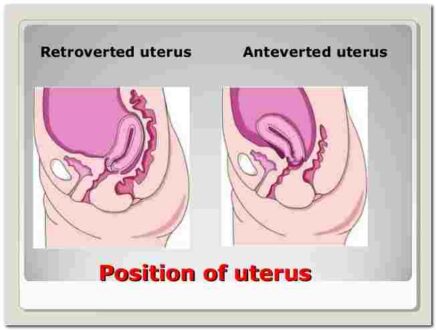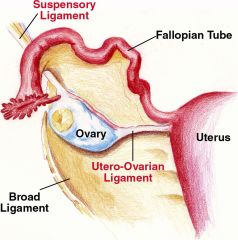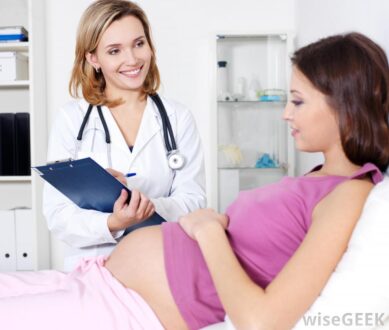Mainly women have an anteverted uterus, whereas some may have Aretroverted generally called a tipped uterus. Hearing these two terms for the first time may make you take a step back, but there is no reason to be worried.
Below in this article you will find information about various positions of uterus, its symptoms and treatment of Anteverted uterus.
An anteverted uterus is a term, which is used by doctors to try to distinguish the position of the uterus. An anteverted uterus is a uterus that is tilted forward towards the bladder while a retroverted uterus points backwards towards the rectum. Many people who aren’t familiar with the word anteverted uterus relate that with something bad and consider it a troubling factor in pregnancy but reality is different.
If you are trying to get pregnant or you recently found out how your uterus is positioned, understanding more about the varying positions of the uterus can help to set your mind at relieve.

The uterus is made up of two parts; the lower cervix and the upper body or fundus.
Cervix is about two inches or more, and the uterus body sits on top, which is the size of a pear. The upper body or fundus can at times be bigger in women who have had a baby and smaller in women in their menopause who have had not baby.

The cervix and body of uterus affix to pelvic sidewalls by a number of ligaments. The ligaments are quiet flexible and they let uterus to tilt somewhat backward or forward.
Women who have had a couple of vaginal deliveries tend to have more flexible ligaments compared to those who never had a baby. It is normal to have anteverted or slightly forward tilt uterus. In this case, the uterus is bend towards the bladder.
Why the uterus tilts forwards?
Doctors are not sure why the tilting of the uterus occurs but much of it is associated with the anatomy as well as body type. In the pelvis, there is a lot of room, which may allow body parts to shift around.
The uterus is attached and held in place by some four ligaments. Two round ligaments are on each side. There is also a vesico-uterine ligament found in front of uterus. A sacro-uterine ligament is found in back of uterus. There is a common believe that the uterus can move freely backward and forward.
If the bladder and rectum are empty, uterus is likely to form a right angle position with vagina. With changes that occur in and around the uterus, they may induce orientation in positioning of uterus in body. Depending on body structure, gynecological history, pregnancies, number of babies, physical health, and menses, the uterine position is able to change.

As time passes, this may go away and uterus go back to its original position after healing; however, some times, the change in position may continue and does not get back to normal. As women grow older, they may have more tilting than they do in youth because the muscles and ligaments tend to grow softer and weaker i.e. lose its elasticity.
Anteverted Uterus Symptoms
- Retroverted uterus may include the following signs and symptoms:
- Uterine retroversion is linked with dyspareunia and dysmenorrhea. In addition, in women with pelvic pain, uterine flexion represents an independent risk for intense menstrual pain.
- Low back pain before and during period, when your uterus is heavier.
- Constipation from the uterus impinging on the rectum, especially right before period or in pregnancy.
- Sciatica caused by compression of the sacral plexus by posterior shift of the uterus.
- Back Ache During Pregnancy If a woman with a RV uterus is able to get pregnant, she may suffer from low back pain and constipation until the adhesions holding the uterus to the posterior wall break free under the increasing weight of the uterus.
- Endometriosis has been theorized that a retroflexion may also cause retrograde blood flow into the abdominal cavity causing endometriosis.
Anteverted uterus Treatment Methods
Treatment options are rarely needed, and include exercises, Pessary and manual repositioning. There is no specific treatment methods required for anteverted uterus, but if the uterus is retroverted, surgical procedures are usually employed to correct it.
Anteverted uterus and pregnancy
Most women who have anteverted uterus may not even be aware of it. This condition is not known to affect the fertility of a woman or the gestation and general sexual health. In most cases, having an anteverted uterus is assumed as normal and may be taken as biological change that can happen.

However, it may result in some discomforts when there is extreme tilting, especially in late stages of pregnancy. It is a rare and it can be easily identified in an ultrasound imaging test and some other routine checkups.
You may seek medical help while experiencing some problems during pregnancy. However, even when a doctor tells you that you have anteverted uterus, it may not be a threatening condition because it is not likely to affect your overall health and fertility.
 Health & Care Information
Health & Care Information 

